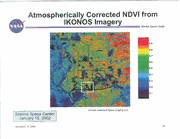
NASA Technical Reports Server (NTRS) 20080021640: Atmospheric Correction Prototype Algorithm for High Spatial Resolution Multispectral Earth Observing Imaging Systems PDF
Preview NASA Technical Reports Server (NTRS) 20080021640: Atmospheric Correction Prototype Algorithm for High Spatial Resolution Multispectral Earth Observing Imaging Systems
I Stennis Space Center -- -- Atmospheric Correction Prototype Algorithm for High Spatial Resolution Multispectral Earth Observing Imaging Syste,ms Mary Pagnutti Science Systems and Applications, Inc. John C. Stennis Space Center, MS 39529 - phone: 228-688-213 5 - e-mail: [email protected] High Spatial Resolution Commercial Imagery Workshop Reston, Virginia, USA November 10,2004 Contributors NASA Applied Sciences Directorate, SSC Tom Stanley Vicki Zanoni Science systems and Applications, Inc. Slawomir Blonski Kara Holekamp Kelly Knowlton .- --D on Prados - ,_ Jeff Russell Robert Ryan -a Lockheed Martin Space Operations David Carver Jerry Gasser Randy Greer Wes Tabor This work was directed by the NASA Applied Sciences Directorate (formerly the Earth Science Applications Directorate) at the John C. Stennis Space Center, Mississippi. Participation in this work by Lockheed Martin Space Operations - Stennis Programs was supported under contract number NAS 13-650. Participation in this work by Computer Sciences Corporation and by Science Systems and Applications, Inc., was supported under NASA Task Order NNS04AB54T. November 10,2004 Atmospheric Correction Stennis Space Center Atmospheric correction is the process of converting satellite signals (at-sensor radiance) to ground reflectances Removes atmospheric and solar illumination effects - Benefits +. '-. - Improves change detection - Used with spectral library based classifiers - Simplifies satellite data intercomp~is'ons Different levels of atmospheric correction yield different approximations of scene reflectance . -a Planetary reflectance - no knowledge of atmosphere - - Ground reflectance using knowledge of atmosphere Ground reflectance using knowledge of atmosphere and adjacency - effects November 10,2004 Atmospheric Correction Alaorithm w Implementations Stennis Space Center Use knowledge of atmosphere to determine the constants necessary to convert satellite signals to scene reflectances - Ground-based reflectance measurements (direct method) - Pseudo-invariant targets - Ground-based atmosphere (a.-e .-r os~lm) easurements - Scene-based aerosol estimates (based on dark pixels) - Climatological atmosphere -- Y - Satellite-based atmospheric measurements This presentation will focus on preliminary results of only the . _ I satellite-based atmospheric correction algorithm. All algorithms I will be evaluated in the coming year. _I November 10,2004 Atmos~hericC orrection Prototv~e II. Stennis Space Center Leverage JAClE commercial imagery radiometric characterizations - IKONOS, QuickBird, OrbView-3 (future) Use daily coverage'from MODlS to provide input data for atmospheric correction - MOD04 Aerosol Optical Thickness I - MOD05 Total Precipitable Water (W' ater Vapor) Ogtical Generate MODIS-like products I 1 Depth - Surface Reflectance (MOD09) - Gridded Vegetation Indices - NDVl (MOD13) Water Vapor, - Near Infrared I 1 November 10,2004 Atmospheric Correction Approach Stennis Space Center MODIS data products MOD04, MOD05 I. + . \ .- +. .- Radiometrically Corrected Spherical Albedo Model I b -n Imagery - - - I v Reflectance Map NDVI Map MODIS (Moderate Resolution Imaging Spectroradiometer) w Stennis Space Center MODIS provides long-term observations from which an enhanced knowledge of global dynamics and processes occurring on the surface of the Earth and in the lower atmosphere can be derived. . MISSIONS: PRODUCT SUMMARY: OWNER: Terra - Dec 1999 Congruent observations of high-priority \ U.S., NASA atmospheric, oceanic, and land-surface Aqua - May 2002 features HERITAGE: .- , VITAL FACTS: AVHRR ,- ;A- Instrument: Whiskbroom imaging radiometer High Resolution Infrared Bands: 36 from 0.4 and 14.5 pm Radiation Sounder (HIRS) -a Landsat TM Spatial Resolution: 250 m (2), 500 m @), 1000 m (29) Coastal Zone Color Scanner Swath: 2,300 km (k55O) from 705 km LINKS: Repeat Time: Global coverage in 1 to 2 days Sensor Site: Design Life: 6 years Data Sites: htt~://daac.asfc.nasa.aov/( ocean and atmospheric) htt~://edcdaac.us~s.aov/main.htm(ll and) November 10,2004 Spherical Albedo Formulation Stennis Space Center The spherical albedo approach approximates the signal observed by the satellite as the summation of the components illustrated below Solar lrradiance Target November 10,2004
